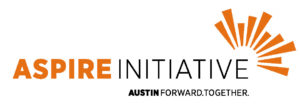
The ASPIRE Initiative: Building a stronger cradle-to-career pipeline in Austin
Our neighborhood is at a critical moment in its
history. Since the 1970s, public and private
disinvestment have caused a crisis state of severe
social and economic decline in Austin and as a
result, we have lost 17% of our population—over
20,000 residents—since 2000. Meanwhile,
hundreds of civic leaders have mobilized around a
powerful vision for a healthy and prosperous future called ASPIRE.
The Aspire Initiative (ASPIRE) mobilizes existing community assets with new investments to impact the growth in educational and economic opportunities for Austinites of all ages.
ASPIRE builds on the momentum of Austin’s quality-of-life plan called ‘Austin Forward. Together.’ (AFT) to create four investments strategically clustered around existing assets in an area bound by Madison, Chicago, Central, and Laramie Avenues. These investments will result in a state of the art early learning, health and recreation center, a vibrant neighborhood high school filled with students, an economic hub that connects low-income residents with real economic opportunity, and 60 units of new affordable housing for purchase so that low-income residents have an opportunity to build wealth. The ASPIRE Initiative is part of a collective vision for a powerful and highly collaborative community with the capacity to create a high quality cradle-to-career educational system and a revitalized economy by and for Austin residents:
- ASPIRE Education & Wellness Campus: This Campus will comprehensively serve 150 families, boost access to quality early learning opportunities and prepare children for kindergarten.
- ASPIRE Housing: For middle, moderate, and low-income households, this multi-tiered approach will ensure that vacant and under-utilized residential properties are revitalized and made available at affordable rents and prices.
- The Aspire Center for Workforce Innovation: Repurposing the former Emmet Elementary School, one of Chicago’s many public schools closed in 2014, into an anchor for commercial revitalization and a destination for top-notch workforce training. Read more about it here.
- ASPIRE ACCA: Supporting the ongoing reinvention of the Austin College and Career Academy (ACCA) will aid the school in reaching a Level1+ status where all local students can attain a quality secondary education.
ASPIRE is led by Westside Health Authority and Austin Coming Together while leveraging support from several other partners. By the Hand Club for Kids will lead the development of an early learning center and health and recreation facility. These investments and the activity they catalyze, will address low education outcomes, rising rates of poverty, and lower rates of homeownership in Austin.
All partners are being provided with technical support by LISC Chicago, the United Way of Metro Chicago, IFF, the Lamar Johnson Collaborative, Purpose Built Communities, and Applegate Thorne-Thompsen.
The problem addressed by the Aspire Center for Workforce Innovation:
Despite progress in Austin over the past several years, there is a great need for workforce training and life
skills development.

By transforming the Emmet School site into the Aspire Center for Workforce Innovation the corner of Madison and Central is primed to become the physical embodiment of “collective impact” and a vital community anchor for systemic change.
Currently, a significant youth population exists in Austin, with 15% being between the ages of 25-34, followed by 13% for 15-24-year-olds, according to the 2010 U.S. Census Bureau and forecasts for 2019. Rush University Medical Center published a report in June 2016 that identified two of several hardship factors within Austin, unemployment for those that are 16+ and lack of high school diploma.
Second, there is a large set of adults that have been dislocated from the workforce. Low education and unemployment are some of the top contributors that affect Austin’s neighborhood status. GCI published a report in May 2019 finding that almost half of Chicago’s young black men are both out of school and out of work, double the national rate. In Chicago, women accounted for 30% (9,315) of adults that don’t have a job nor attending school while men were at 45% (12,805), within the 20-24 age cohort based on the 2017 ACS data.
This research has found that employment and in-demand skillsets that undergo a perpetual change intensifies these problems and causes individuals to endure hardships that span from rising costs of living, stagnant wages, and technological advances in work environments. The domino effect of a poor neighborhood education system and student decline leads toward an unstable local economy and contributes to a stigma of Austin.
The Solution:
The once-bustling intersection of Madison Street and Central Avenue will be revived by repurposing the former Emmet Elementary School, one of Chicago’s many public schools closed in 2014, into an anchor for commercial revitalization and a destination for top-notch workforce training. The Aspire Center will serve as a centralized location for Austin’s youth and unemployed and underemployed adults seeking career training and support. The Aspire Center will
- Create linkages among programmatic initiatives and shared facilities;
- Expand and support local resources for skills training in high demand economic sectors, such as advanced manufacturing; and
- Support small businesses and entrepreneurs.
LEARN MORE:
- Aspiring to change lives: How the Aspire Center for Workforce Innovation will bring opportunities to Austin (published June 2022)
- A look inside the Aspire Center for Workforce Innovation (published June 2022)
- The Aspire Center: A timeline (published June 2022)
- A beacon of hope for Austin: the Aspire Initiative
- Check out the Lamar Johnson website.


